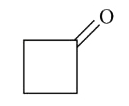(A)(C4H8O)H3O⊕−−−→(B)CrO3−−−−−→acetic acid(C)CH2N2−−−→Δ(D)
The compound 'D' is




The correct Answer is:A
To solve the question step by step, we will analyze the transformations of compound A (C₄H₈O) through the given reactions to determine the final product D.
Step 1: Identify Compound A
Given that A is C₄H₈O, we can start by calculating its degree of unsaturation (DOU) to understand its structure.
Degree of Unsaturation Calculation:
- Formula: DOU = (C + 1 - H + X - N) / 2
- For A (C₄H₈O):
- C = 4
- H = 8
- X = 0 (no halogens)
- N = 0 (no nitrogens)
Plugging in the values:
DOU=(4+1−8+0−0)/2=(5−8)/2=−3/2
This indicates that there is one degree of unsaturation, suggesting that A is an unsaturated alcohol.
Step 2: React A with H₃O⁺
When A reacts with H₃O⁺ (which provides H⁺ and water), it undergoes hydration to form an alcohol (B). The reaction mechanism involves protonation of the double bond, leading to the formation of a carbocation, which is then attacked by water.
1. Protonation of the double bond leads to the formation of a carbocation.
2. Water attacks the carbocation, resulting in the formation of an alcohol.
Thus, compound B is an unsaturated alcohol derived from A.
Step 3: React B with CrO₃ in Acetic Acid
Next, B is reacted with CrO₃ in the presence of acetic acid, which acts as an oxidizing agent. Since B is an alcohol, it will be oxidized to a ketone.
- The oxidation of the alcohol results in the formation of a carbonyl compound (C), specifically a cyclobutanone.
Step 4: React C with CH₂N₂ (Diazomethane)
Finally, compound C (cyclobutanone) is reacted with CH₂N₂ (diazomethane) under heating conditions. This reaction involves carbene insertion, where the carbene (generated from CH₂N₂) inserts into the carbonyl compound.
1. The carbene (CH₂) inserts into the C=O bond of cyclobutanone.
2. This results in the formation of cyclopentanone (D).
Conclusion
The final product D after all the reactions is cyclopentanone.
Final Answer
The compound 'D' is cyclopentanone.
---
Given that A is C₄H₈O, we can start by calculating its degree of unsaturation (DOU) to understand its structure.
- Formula: DOU = (C + 1 - H + X - N) / 2
- For A (C₄H₈O):
- C = 4
- H = 8
- X = 0 (no halogens)
- N = 0 (no nitrogens)
DOU=(4+1−8+0−0)/2=(5−8)/2=−3/2
This indicates that there is one degree of unsaturation, suggesting that A is an unsaturated alcohol.
When A reacts with H₃O⁺ (which provides H⁺ and water), it undergoes hydration to form an alcohol (B). The reaction mechanism involves protonation of the double bond, leading to the formation of a carbocation, which is then attacked by water.
2. Water attacks the carbocation, resulting in the formation of an alcohol.
Next, B is reacted with CrO₃ in the presence of acetic acid, which acts as an oxidizing agent. Since B is an alcohol, it will be oxidized to a ketone.
Finally, compound C (cyclobutanone) is reacted with CH₂N₂ (diazomethane) under heating conditions. This reaction involves carbene insertion, where the carbene (generated from CH₂N₂) inserts into the carbonyl compound.
2. This results in the formation of cyclopentanone (D).
The final product D after all the reactions is cyclopentanone.
The compound 'D' is cyclopentanone.
Topper's Solved these Questions
Similar Questions
Knowledge Check
(A)(C_(4)H_(8)O)overset(H_(3)O^(o+)(to)(B)underset("एसीटिक अम्ल")overset(CrO_(3))(to)(C)underset(Delta)overset(CH_(2)N_(2))(to)(D)
उपरोक्त अभिक्रिया में यौगिक D हैA B
B C
C D
D
H3C−CH2−CH3∣CH−C∣∣O−NH2Br2+KOH−−−−−−→ΔA1.CH3I(excess)−−−−−−−−−→2.AgOH,ΔB The major product (B) is:
ACH3−CH2−CH=CH2B CH3C−CH=CH−CH3D
CH3C−CH=CH−CH3D
Consider the following sequence of reactions
ACrO3−−→B(C4H8O3)Warm−−−→CH3O∣∣CCH3+CO2
The compound (A) is :AHOCH2CH2CH2COOHBCH3CH(OH)CH2COOHCCH3CH2CH(OH)COOHD(CH3)2C(OH)COOH
(CH3)2+HCN→[A]H3O+−−−→[B]H2SO4−−−→Heat[C]
View SolutionIdentify the compound 'D' in the following series of reaction.
CH3−CH3| CH−CH2−CH2−BrAlc. KOH−−−−−→Δ'A'(i) Conc. H2SO4−−−−−−−−−→(ii) H2O,Δ'B'Majorproduct+'C'Minorproduct
'B'Hl,Δ−−−→−H2O'D'(Majorproduct)+'E'(Minorproduct)
View SolutionCH3CCl2CH3NaOH−−−−−−→HydrolysisP−H2O−−−→QOxidation−−−−−−−→[O]R
The compound R is
View SolutionMg3N2H2O−−→A(gas)CuO−−→ΔB+C(g)+H2O,C(g) can be obtained by heating:
View Solution2Ph−O∣∣C−CH3Mg−Hg−−−−→H2OConc.H2SO4−−−−−−−→ΔKMnO4H⊕−−−−−−−→
The final product is
View Solution
_E01_782_Q01.png)